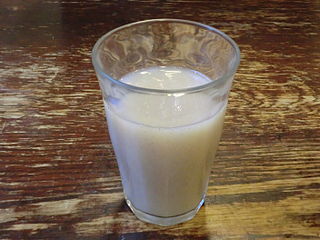
Miso is a traditional Japanese seasoning. It is a thick paste produced by fermenting soybeans with salt and kōji and sometimes rice, barley, seaweed, or other ingredients. It is used for sauces and spreads, pickling vegetables, fish, or meats, and mixing with dashi soup stock to serve as miso soup, a Japanese culinary staple. Miso is high in protein and rich in vitamins and minerals, and it played an important nutritional role in feudal Japan. Miso is still widely used in both traditional and modern cooking in Japan and has been gaining worldwide interest.

Sake or saké, also referred to as Japanese rice wine, is an alcoholic beverage of Japanese origin made by fermenting rice that has been polished to remove the bran. Despite the name Japanese rice wine, sake, and indeed any East Asian rice wine, is produced by a brewing process more akin to that of beer, where starch is converted into sugars that ferment into alcohol, whereas in wine, alcohol is produced by fermenting sugar that is naturally present in fruit, typically grapes.

A mold or mould is one of the structures that certain fungi can form. The dust-like, colored appearance of molds is due to the formation of spores containing fungal secondary metabolites. The spores are the dispersal units of the fungi. Not all fungi form molds. Some fungi form mushrooms; others grow as single cells and are called microfungi.

Aspergillus niger is a mold classified within the Nigri section of the Aspergillus genus. The Aspergillus genus consists of common molds found throughout the environment within soil and water, on vegetation, in fecal matter, on decomposing matter, and suspended in the air. Species within this genus often grow quickly and can sporulate within a few days of germination. A combination of characteristics unique to A. niger makes the microbe invaluable to the production of many acids, proteins and bioactive compounds. Characteristics including extensive metabolic diversity, high production yield, secretion capability, and the ability to conduct post-translational modifications are responsible for A. niger's robust production of secondary metabolites. A. niger's capability to withstand extremely acidic conditions makes it especially important to the industrial production of citric acid.

Kikkoman Corporation is a Japanese food manufacturer. Its main products and services include soy sauce, food seasoning and flavoring, mirin, shōchū, and sake, juice and other beverages, pharmaceuticals, and restaurant management services.

Amazake is a traditional sweet, low-alcohol or non-alcoholic Japanese drink made from fermented rice. Amazake dates from the Kofun period, and it is mentioned in the Nihon Shoki. It is part of the family of traditional Japanese foods made using the koji mold Aspergillus oryzae, which also includes miso, soy sauce, and sake.

Shōchū is a Japanese distilled beverage. It is typically distilled from rice, barley, sweet potatoes, buckwheat, or brown sugar, though it is sometimes produced from other ingredients such as chestnut, sesame seeds, potatoes, or even carrots.

Awamori is an alcoholic beverage indigenous and unique to Okinawa, Japan. It is made from long grain indica rice, and is not a direct product of brewing but of distillation. The majority of awamori made today uses indica rice imported from Thailand, as the local production is largely insufficient to meet domestic demand, which has risen considerably in recent years.

Aspergillus is a genus consisting of several hundred mould species found in various climates worldwide.

Aspergillus oryzae, also known as kōji mold, is a filamentous fungus used in East Asia to saccharify rice, sweet potato, and barley in the making of alcoholic beverages such as sake and shōchū, and also to ferment soybeans for making soy sauce and miso. However, in the production of fermented foods of soybeans such as soy sauce and miso, Aspergillus sojae is sometimes used instead of A. oryzae. Incidentally, in China and Korea, the fungi used for fermented foods for a long time in the production of traditional alcoholic beverages were not A. oryzae but fungi belonging to Rhizopus and Mucor. A. oryzae is also used for the production of rice vinegars. Barley kōji (麦麹) or rice kōji (米麹) are made by fermenting the grains with A. oryzae hyphae.

Fermented tea is a class of tea that has undergone microbial fermentation, from several months to many years. The exposure of the tea leaves to humidity and oxygen during the process also causes endo-oxidation and exo-oxidation. The tea leaves and the liquor made from them become darker with oxidation. Thus, the various kinds of fermented teas produced across China are also referred to as dark tea, not be confused with black tea. The most famous fermented tea is pu'er produced in Yunnan province.

Moyasimon: Tales of Agriculture, known in Japan as Moyashimon (もやしもん), is a Japanese manga series by Masayuki Ishikawa. It was serialized in Kodansha's seinen magazine Evening from July 2004 to June 2013 and moved to the magazine Monthly Morning Two, where it concluded in January 2014. The series follows Tadayasu Sawaki, a first-year college student at an agricultural university, who has a unique ability to see and communicate with microorganisms. Del Rey Manga licensed the manga, but only released two volumes in English in North America. An 11-episode anime television series adaptation, animated by Shirogumi and Telecom Animation Film, aired between October and December 2007 on Fuji TV's Noitamina programming block. An 11-episode live action adaptation was aired on Noitamina between July and September 2010. An 11-episode animated second season titled Moyasimon Returns aired from July to September 2012.

Sake kasu (酒粕) or sake lees is the name given to the pressed lees left over from the production of sake. It is used as a cooking ingredient that is white in color, having a paste-like texture. The taste of sake kasu is fruity and has a similar taste to sake. A by-product of Japanese sake production, it typically contains 8% alcohol, has high nutritional value, and might have health benefits.
The Mathematical Society of Japan is a learned society for mathematics in Japan.

Aspergillus sojae is a species of fungus in the genus Aspergillus.
Symbiotic fermentation is a form of fermentation in which multiple organisms interact in symbiosis in order to produce the desired product. For example, a yeast may produce ethanol, which is then consumed by an acetic acid bacterium. Described early on as the fermentation of sugars following saccharification in a mixed fermentation process.

Aspergillus awamori is the scientific name for what, until about 2013, was considered a type of black Aspergillus used to awamori and shōchū. Due to international research in 2013, the black kōji used to make awamori and shōchū is now commonly referred to by the scientific name Aspergillus luchuensis.
This glossary of sake terms lists some of terms and definitions involved in making sake, and some terms which also apply to other beverages such as beer. Sake, also referred to as a Japanese rice wine, is an alcoholic beverage made by fermenting rice that has been polished to remove the bran. Unlike wine, in which alcohol is produced by fermenting sugar that is naturally present in fruit, sake is produced by a brewing process more akin to that of beer, where starch is converted into sugars which ferment into alcohol.

Miki is a Japanese drink from Amami Oshima, Kagoshima Prefecture and Okinawa Prefecture, areas known for health and longevity. It is an arrangement based on omiki, a beverage used in Shinto rituals and festivals. Miki is made from fermented rice, sweet potatoes, and sugar and was traditionally made in every household on the island. It is sold commercially as a soft drink, with many specialized shops selling it, and some grocery stores.














